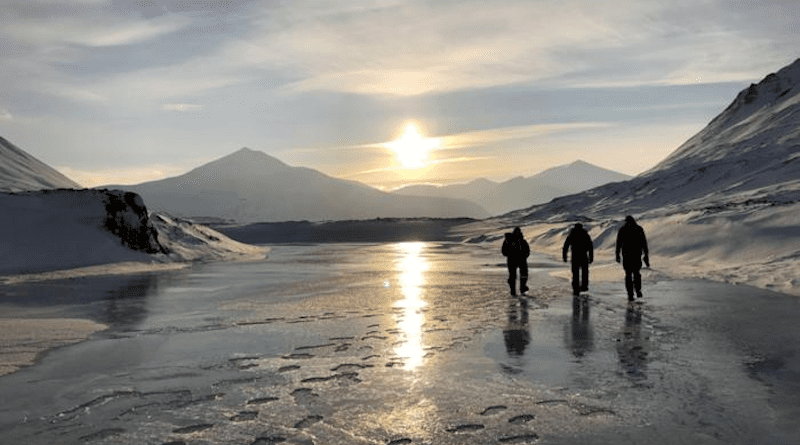Shrinking Arctic Glaciers Are Unearthing A New Source Of Methane
As the Arctic warms, shrinking glaciers are exposing bubbling groundwater springs which could provide an underestimated source of the potent greenhouse gas methane, finds new research published today in Nature Geoscience.
The study, led by researchers from the University of Cambridge and the University Centre in Svalbard, Norway, identified large stocks of methane gas leaking from groundwater springs unveiled by melting glaciers.
The research suggests that these methane emissions will likely increase as Arctic glaciers retreat and more springs are exposed. This, and other methane emissions from melting ice and frozen ground in the Arctic, could exacerbate global warming.
“These springs are a considerable, and potentially growing, source of methane emissions — one that has been missing from our estimations of the global methane budget until now,” said Gabrielle Kleber, lead author of the research who is from Cambridge’s Department of Earth Sciences.
Scientists are concerned that additional methane emissions released by the Arctic thaw could ramp-up human-induced global warming. The springs the researchers studied hadn’t previously been recognized as a potential source of methane emissions.
Kleber spent nearly three years monitoring the water chemistry of more than a hundred springs across Svalbard, where air temperatures are rising two times faster than the average for the Arctic. She likens Svalbard to the canary in the coal mine of global warming, “Since it is warming faster than the rest of the Arctic, we can get a preview of the potential methane release that could happen at a larger scale across this region.”
Professor Andrew Hodson, study co-author from the University Centre in Svalbard said, “Living in Svalbard exposes you to the front-line of Arctic climate change. I can’t think of anything more stark than the sight of methane outgassing in the immediate forefield of a retreating glacier.”
Previously, research has centred on methane release from thawing permafrost (frozen ground). “While the focus is often on permafrost, this new finding tells us that there are other pathways for methane emissions which could be even more significant in the global methane budget,” said study co-author Professor Alexandra Turchyn, also from Cambridge’s Department of Earth Sciences.
Hodson added, “Until this work was conducted, we didn’t understand the source and pathways of this gas because we were reading about studies from completely different parts of the Arctic where glaciers are absent.”
The methane-delivering springs they identified are fed by a plumbing system hidden beneath most glaciers, which taps into large groundwater reserves within the underlying sediments and surrounding bedrock. Once the glaciers melt and retreat, springs appear where this groundwater network punches through to the surface.
The researchers found that methane emissions from glacial groundwater springs across Svalbard could exceed 2,000 tonnes over the course of a year — which equates to roughly 10% of the methane emissions resulting from Norway’s annual oil and gas energy industry.
This source of methane will likely become more significant as more springs are exposed, said Kleber, “If global warming continues unchecked then methane release from glacial groundwater springs will probably become more extensive.”
Glacial groundwater springs aren’t always easy to recognize, so Kleber trained her eye to pick them out from satellite images. Zooming in on the areas of land exposed by the retreat of 78 glaciers across Svalbard, Kleber looked for tell-tale blue trickles of ice where groundwater had leaked to the surface and frozen. She then travelled to each of these sites by snowmobile to take samples of the groundwater at locations where the ice had blistered due to pressurized water and gas build up.
When Kleber and the team profiled the chemistry of the water feeding these springs, they found that all bar one of the sites studied were highly concentrated with dissolved methane — meaning that, when the spring water reaches the surface, there is plenty of excess methane that can escape to the atmosphere.
The researchers also identified localized hotspots of methane emissions, which were closely related to the type of rock from which the groundwater emerges. Certain rocks like shale and coal contain natural gases, including methane, produced by the breakdown of organic matter when the rocks formed. This methane can move upwards through fractures in the rock and into the groundwater.
“In Svalbard we are beginning to understand the complex and cascading feedbacks triggered by glacier melt — it seems likely that there are more outcomes like this which we have yet to uncover,” said Kleber.
“The amount of methane leaking from the springs we measured will likely be dwarfed by the total volume of trapped gas lying below these glaciers, waiting to escape,” said Hodson, “That means we urgently need to establish the risk of a sudden increase in methane leakage, because glaciers will only continue to retreat whilst we struggle to curb climate change.”

